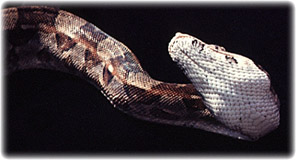Difference between revisions of "Snake Neurological Diseases"
| Line 15: | Line 15: | ||
*'''Bacterial''' - Bacterial infections, including Staphylococcus aureus and mycobacteria, have been reported to cause neurological disease and abscesses in the vertebral canal. | *'''Bacterial''' - Bacterial infections, including Staphylococcus aureus and mycobacteria, have been reported to cause neurological disease and abscesses in the vertebral canal. | ||
| − | *'''Fungal''' - Cryptococcus neoformans has been associated with neurological disease. Diagnosis can be confirmed by serology or isolation from CSF. | + | *'''Fungal''' - ''[[Cryptococcus neoformans]]'' has been associated with neurological disease. Diagnosis can be confirmed by serology or isolation from CSF. |
*'''Parasitic''' - Protozoal neurological disease has been reported in snakes. Acanthmoebic encephalitis causes spasmodic opisthotonus and toxoplasmosis has been associated with meningoencephalitis. | *'''Parasitic''' - Protozoal neurological disease has been reported in snakes. Acanthmoebic encephalitis causes spasmodic opisthotonus and toxoplasmosis has been associated with meningoencephalitis. | ||
Revision as of 12:51, 28 October 2010
| This article has been peer reviewed but is awaiting expert review. If you would like to help with this, please see more information about expert reviewing. |
Neurological disease is relatively common in snakes. Viral infections may present with neurological signs and hypothiaminosis is very common in garter snakes.
Examination
As with other problems of snakes, history-taking is critical for diagnosis. Signalment information can help determine the cause since many neurological diseases are more prevalent in certain taxa. Husbandry information will help to determine whether the nervous system is involved specifically or secondarily. Clinical signs of neurological disease in snakes vary from very subtle to severe. There may be only a mild decrease in activity and a drop off in appetite. More obvious signs include disorientation, incoordination, loss of righting reflex, paresis, paralysis, head tremors, opisthotonous and convulsions.
Diagnosis
The aetiology of neurological disease can be suggested by signalment. Inclusion body disease (IBD) is almost always seen in Boidae. Ophidian paramyxovirus (OPMV) occurs principally in Viperidae. Hypothiaminosis is common in fish-eating snakes such as garter snakes. Disorientation and sluggishness may be attributed to a wide variety of causes but may be simply caused by an inappropriate environmental temperature. Physical examination may rule out cases of trauma. The use of diagnostic aids may identify the cause: radiography may reveal fractures, haematology may indicate an infectious cause, and serology may identify OPMV. Response to thiamine is diagnostic for hypothiaminosis. However sometimes the aetiology is only found upon necropsy. Perivascular cuffing in CNS issue may be associated with viral infections.
Causes of neurological disease
There are many causes of neurological disease in snakes. Here’s a brief overview.
- Viral - Two viral diseases have been reported to cause neurological problems in snakes – Inclusion Body Disease and OMPV. OPMV is primarily associated with respiratory pathology but can be associated with CNS disease. The clinical significance of infection with western equine encephalitis and Venezuelan equine encephalitis is unknown.
- Bacterial - Bacterial infections, including Staphylococcus aureus and mycobacteria, have been reported to cause neurological disease and abscesses in the vertebral canal.
- Fungal - Cryptococcus neoformans has been associated with neurological disease. Diagnosis can be confirmed by serology or isolation from CSF.
- Parasitic - Protozoal neurological disease has been reported in snakes. Acanthmoebic encephalitis causes spasmodic opisthotonus and toxoplasmosis has been associated with meningoencephalitis.
- Nutritional - Thiamine deficiency is the most common nutritional cause of neurological disease in snakes. Snakes fed incorrectly prepared fish are at risk. Hypobiotinosis may develop from feeding raw egg whites containing avidin, which has anti-biotin activity.
- Trauma - Trauma neuropathies may occur after direct trauma to the head and vertebral column.
- Congenital - A caudal coiling problem has been seen in newborn boa constrictors. At necropsy there was a lymphocytic infiltrate in the perimysium of the epaxial muscles.
- Metabolic - Gout-associated neurological disease may result from formation of tophi in CNS tissue.
- Toxicosis - Insecticide poisoning, most commonly organophosphate, has been reported in snakes and caused convulsions. Ivermectin overdose has been reported to cause neuromuscular weakness.
- Neoplasia - Reports of neoplasia of the nervous system of snakes are uncommon but leukaemias have been associated with neurological disease.
- Behavioural - Aggressive behaviour may be normal in some species such as anacondas. However, aggression in large pythons has been associated with sudden changes in the diet. Some large pythons also become conditioned to become aggressive by some feeding techniques.
Therapy
Treatment of neurological disease involves both supportive care and aetiology related therapy. Some forms of neurological disease such as trauma may require up to one year of supportive care before snakes will begin to take prey spontaneously. Months of supportive care are often required for neurological deficits to repair but in many cases they may never be restored to full function. In some cases euthanasia is probably the most humane act. Aetiology related therapy may not be possible in many cases.
For more information, see Snake Supportive Care.
Prevention
Attention to diet and husbandry is usually the most important part of disease prevention.
For further information, see Snake Feeding and Digestion and Snake Housing.
